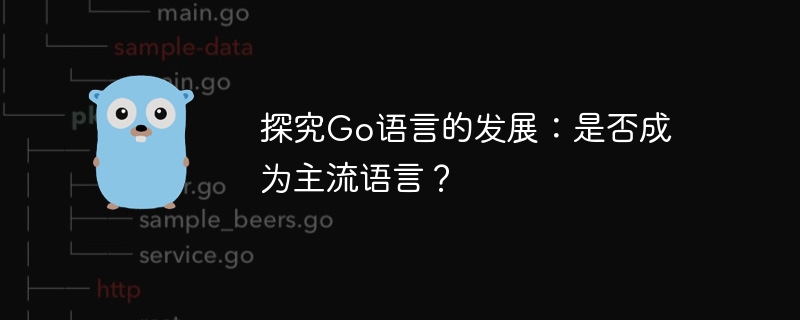Home >Backend Development >Golang >Explore the development of Go language: Has it become a mainstream language?
Explore the development of Go language: Has it become a mainstream language?
- 王林Original
- 2024-03-14 10:45:03997browse

As an open source, statically typed programming language, Go language was developed by Google and first released in 2007. It has attracted the attention of developers since its inception. Its design goal is to increase programmer productivity, especially for building large, high-performance systems. Over the past few years, Go's influence and recognition in the world of software development has gradually increased, but the question still remains: will it become a mainstream programming language?
1. Features of Go language
- Strong concurrency
Go language inherently supports concurrent programming and provides a simple and effective concurrency model through goroutine and channel mechanisms. This makes the Go language outstanding in handling concurrent tasks and easy to write multi-threaded programs.
Sample code:
package main
import "fmt"
func count(c chan int) {
for i := 0; i < 5; i++ {
c <- i
}
close(c)
}
func main() {
c := make(chan int)
go count(c)
for i := range c {
fmt.Println(i)
}
}- Rich built-in tools
Go language has built-in unit testing, performance testing, documentation tools, etc., which greatly simplifies the developer's workflow . In addition, the standard library provides a wealth of functions, covering file operations, network communication, HTTP processing, etc.
Sample code:
package main
import (
"testing"
)
func Add(x, y int) int {
return x + y
}
func TestAdd(t *testing.T) {
if Add(1, 2) != 3 {
t.Error("1+2 should be 3")
}
}- Simple deployment
Through static compilation, Go language programs can be easily deployed to various platforms without additional operations. Environmental dependence. This gives Go language advantages in cloud computing, containerized applications and other fields.
Sample code:
# 编译为可执行文件 go build main.go # 运行程序 ./main
2. Development status of Go language
- More and more projects are developed using Go language, such as Docker and Kubernetes Well-known projects such as Go are implemented in Go language. The successful application of these projects has led more developers to try to learn and use the Go language.
- Go language is also increasingly used in the cloud native field, especially in container orchestration, microservice architecture, etc. Go language has become the language of choice for many enterprises due to its concurrency and simple deployment.
3. Limitations of Go language
- Compared with some old programming languages, the ecology of Go language is relatively small, especially in some specific fields of libraries and frameworks Support is not as good as other languages. This makes some developers may prefer other languages when choosing a technology stack.
- The syntax and features of the Go language are relatively simple, but sometimes they are a bit obscure and difficult to understand. It may require a certain learning curve for beginners.
In general, Go language, as an emerging programming language, has achieved considerable success in the development process, but there is still a certain way to go before it can become a mainstream language. Developers need to work together to continuously improve the language and ecology to make it more powerful and popular.
I hope that through the exploration of this article, readers can have a clearer understanding of the current development status of the Go language and understand its potential and prospects in the field of programming. I hope that the Go language will continue to improve and become one of the first choices for more developers.
The above is the detailed content of Explore the development of Go language: Has it become a mainstream language?. For more information, please follow other related articles on the PHP Chinese website!
Related articles
See more- Detailed explanation of mathematics and random numbers in the Python standard library (math package, random package)
- What are the methods to define an array in Go language?
- How to run go language program
- How to use container orchestration tools in Java to manage and deploy containerized applications?
- How to build reliable containerized applications with React and Kubernetes

